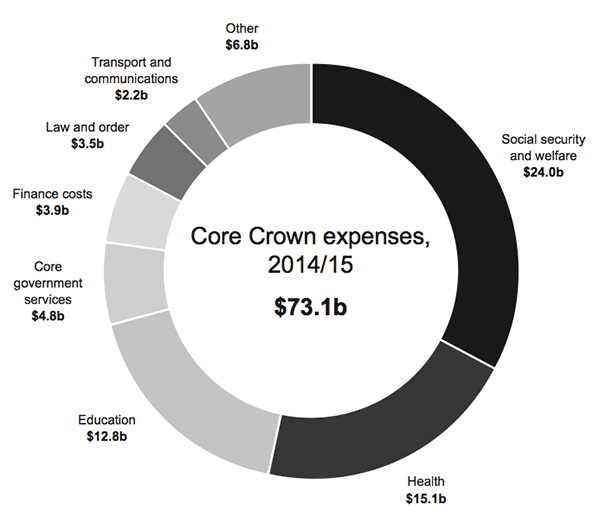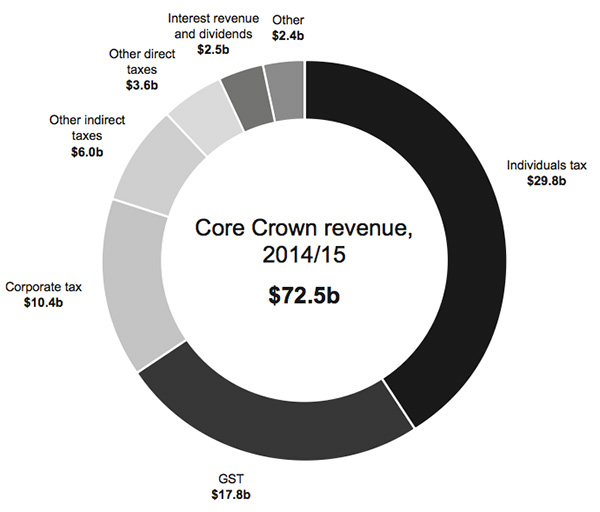Surplus
An important aspect of the Budget announcement was the “return to surplus” predicted for the 2014-2015 year. What this means, essentially, is that more money will come in than will be put out, a goal the current government has had since its rise to power. Spending, therefore, is tightly monitored and accounted for in terms of money spent and money earned. Terms thrown around on the Treasury’s summary are “expenditure restraint” and “reprioritisation and revenue raising initiatives,” if that gives a rough idea of what this government’s strategy has been.
The above graph visualises how this surplus will look in the coming years, and the amount of contrast between 2012/13-2014/15 is stark. A note to remember, however, is that the economic crisis in 2008 shattered Bill English’s dreams of surpluses for some time, and damaged the entire economic metric of the country. And we mustn’t forget Christchurch, which is still very much a target of National’s spending (and rightly so). So don’t take these figures out of context.
Where the money goes and where it comes from
The National government has been quick to point out that two thirds of its Budget expenditure goes towards social security and welfare, health, and education. The graph below shows the distribution of “core Crown expenses” for the coming year.
This next graph shows where the money comes from – mainly taxes. Taxes tend to get people riled up, as I’m sure is already evident given the existence of the New Zealand Tax Payers Union and that one middle-aged Southland man everyone has heard utter “my taxes are paying for this.” This is not the place to discuss tax policies, types of taxes, and how they work, but the matching graphs do well to help visualise the way our taxes are distributed.

Key Changes
The focus of this Budget has largely been on children and families, an important focus given the noise surrounding income inequality and the child poverty that continues to plague our nation. With this in mind, the government has introduced two main measures on this front: paid parental leave will be increased from 14 to 18 weeks over the next two years; and doctors visits will be free for children under 13. Both of these are good initiatives, and extremely helpful for those young families who are struggling to keep their heads above the water; in terms of child poverty, free doctor’s visits will help reduce the myriad of preventable diseases plaguing our youngest and poorest.For those of you with cars, the Budget is trying to make life easier for you by reducing ACC levies, with a notable (possible) cut being $130 for private vehicles, and if you have a car and live in Auckland, you’ll be happy to know the NZ Transport Agency is being loaned (interest free, just like our student loans) $375 million for Auckland transport. Old favourite Paula Bennett also has a new beneficiary package ready to go, targeting those beneficiaries who cannot get work and helping them get work.
Criticisms
The main criticisms of this Budget are that a) it could do more, and b) it could do more for more people. It is not a massively inflammatory budget, and even the most leftist among you can’t deny that free healthcare for the under 13s is good; but that is one good thing, not an entire budget of good things for struggling people. Much of the criticism surrounds a lack of real child poverty alleviation beyond the doctor’s visits (housing, for example, is a nebulous issue that needs attention). These are surface-level solutions, and more must be done to address such pressing issues.David Cunliffe dubbed the Budget the “fudge-it Budget” (looking very proud of himself for the rhyme), arguing that the surplus is only there because of the asset sales. In an interview with One News, Cunliffe succinctly explains that it’s “a wafer-thin surplus that is concocted by holding back ACC levies, cutting back the re-build of Christchurch, and dreaming up an interest-free [loan] to Auckland instead of really investing in its transport.” Winston called it “complacent and disappointing,” while Russel Norman argued “the budget won’t help everyday New Zealanders struggling with rising power bills, rising house prices and increasing interest rates.”
Whether or not you support the Budget will probably depend on where you sit on the spectrum, and for an election year, what has been revealed is hardly surprising. For those swing voters who are now leaning towards National, don’t forget their mistakes and the people they’ve left behind; for those swing voters who are now leaning towards Labour, don’t forget their inconsistent leadership and struggle to regain legitimacy; for those swing voters who are now leaning towards the Greens, don’t forget about the pixies at the bottom of the garden. Just as the government has to balance the books, we have to balance the good and the bad.
Regardless of what you think of the Budget, however, there is one irrefutable good that can cause us all a sigh of relief: we’re not Australia, and our Budget is not even remotely as abysmal as theirs.


